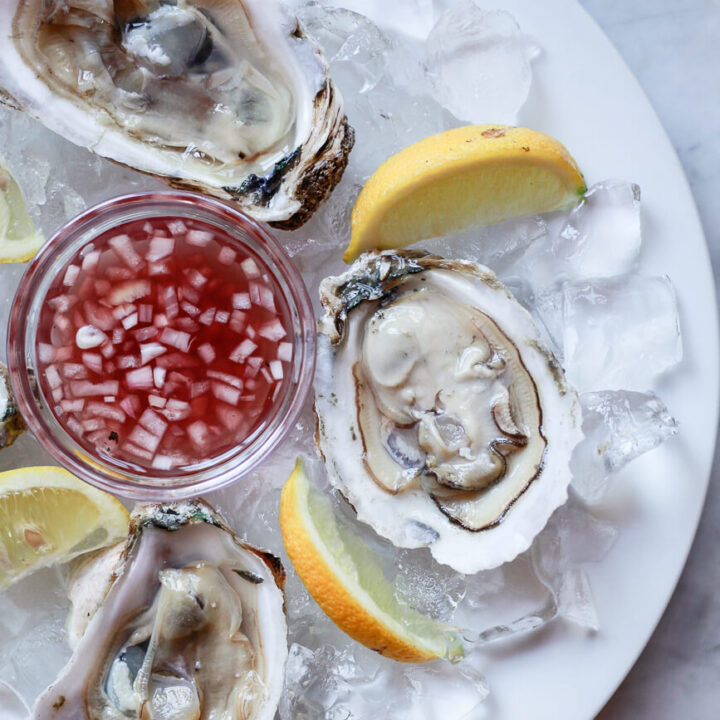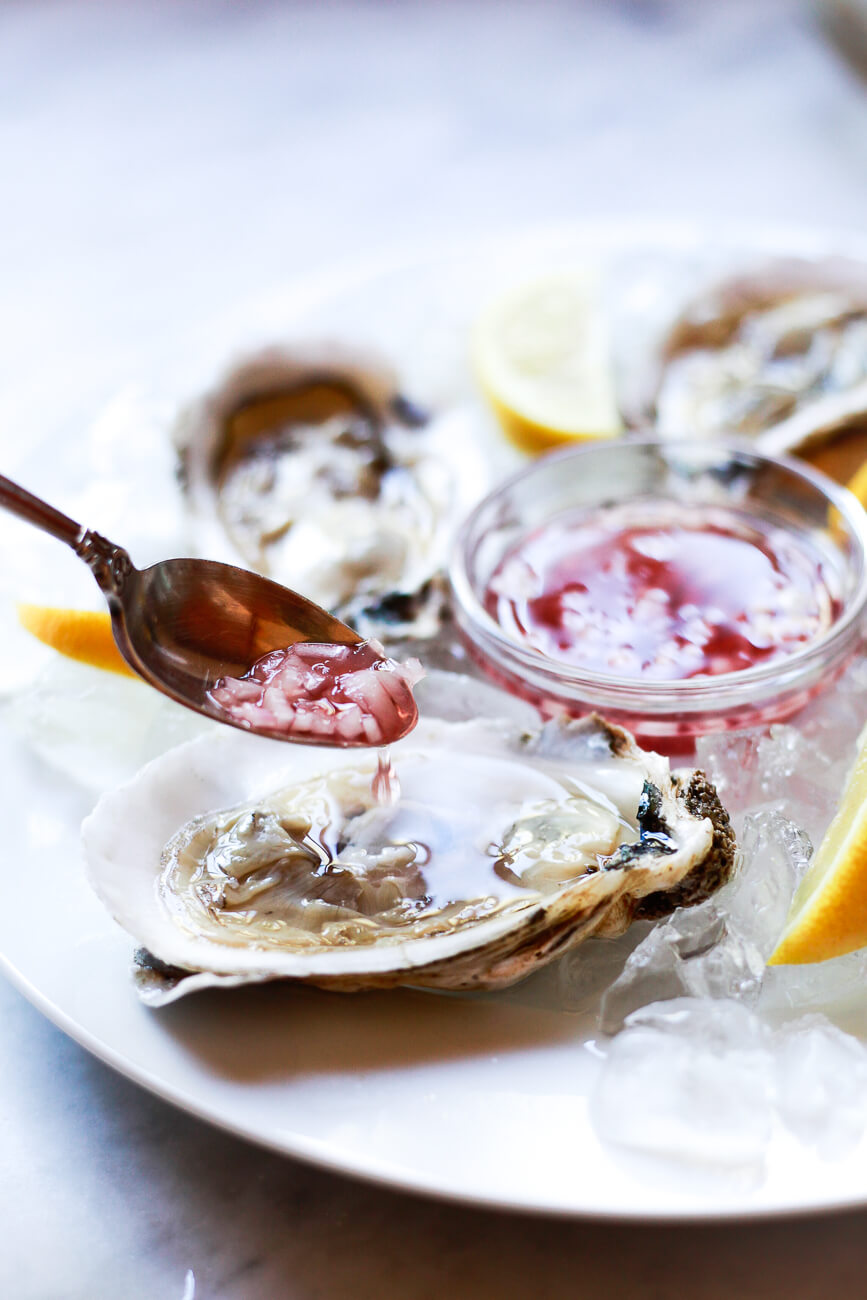Oysters: What Do They Taste Like and How to Eat Them
Have you ever wondered how to eat oysters? Or maybe even what are oysters and what do they taste like? Here’s everything you need to know.

Approximately 95% of the oysters consumed worldwide are farm-raised. While they’re in high demand, many people have never tried raw oysters on the half shell. As a result, they’re missing out on one of the most romantic dishes in the world. They are also on our list of Most Expensive Foods.
In this article, we answer questions like: What do oysters taste like? Are oysters good for you? How to eat oysters?
Like our other guide to what can be mysterious ingredients such as Mushrooms, Truffles, Uni, and Caviar, this is a comprehensive article. Continue reading to learn all about oysters for your next special-occasion meal.
What Are Oysters?
Oysters are a type of ocean shellfish, specifically bivalve mollusks. They live in coastal waters and congregate around piers, large rocks, or old shells. As they get bigger, they fuse together and create a structure similar to a coral reef.
While creating a structure that doubles as a habitat for other animals and plants, they also help filter the water by feeding on algae.
Are Oysters Vegan?
The answer to the question, ‘are oysters vegan,’ depends on an individual’s definition of vegan. Some vegetarians and vegans are comfortable eating mollusks such as mussels and oysters because they have no central nervous system or brain.
As bivalve mollusks, oysters are definitely not plants, so they would not be considered plant-based. However, with no brain, it’s unlikely mollusks feel pain the way other animals and fish do. For this reason, some vegans will eat oysters, and as we’ll go over, they can be a good source of zinc and vitamin B12.

Image: Shutterstock
Shellfish Sustainability
According to ocean farmer, Bren Smith in The Ocean Solution film, oysters and mussels are one of the most sustainable foods. Beef is around 28kg of C02 per 1kg of beef, while mussels can be 0.6kg of C02 per kg of mussel meat, which is lower than even most vegan sources of protein.
Not only are they sustainable, but shellfish farming can actually be beneficial to the environment, as they clean the ocean and create a thriving underwater ecosystem for other sea life.
As one of the greenest foods around, oysters are a fantastic environmentally-friendly protein choice.
Are Oysters Good for You?
One common question by oyster-eaters is, ‘are oysters good for you?’ The good news is that regardless of the varieties of oysters you prefer, an oyster offers plenty of health benefits.
Like other types of shellfish, oysters are low in calories. While cooked oysters, such as fried oysters, are less heart-healthy, they are still a better low-calorie option than other fried foods.
They’re also rich in essential nutrients such as vitamin d, copper, iron, b12, and zinc.
Those who are pregnant or have weakened immune systems should avoid raw shellfish.
Are Oysters Alive?
You might be surprised to learn that when you eat oysters on the half shell they are indeed alive. If you’re eating raw oysters, you definitely want to make sure they are fresh, alive, and cold. Of course, if you’re cooking them in the oven or on the grill they will not be alive when consumed.
Are Oysters an aphrodisiac?
An aphrodisiac is a food or substance that affects a person’s sexual experience. Aphrodisiacs can increase sexual attraction, desire, or pleasure. Since oysters are considered a romantic food, many people wonder, ‘are oysters an aphrodisiac?’
While those who enjoy oysters experience a boost in their mood when eating them, there’s no scientific evidence suggesting oysters are an aphrodisiac. However, since the answer to “Are oysters healthy for you?” is yes, they can contribute to a healthy sex drive.
Oysters do contain high levels of mood-boosting nutrients, vitamins, and minerals such as essential fatty acids DHA and EPA.
What Do Oysters Taste Like?
Most people understand that oysters are seafood, but how do they compare to other types of seafood, and what do oysters taste like? The answer depends on several factors, such as the oyster variety, geographical location, and more. Like wine and other agricultural products, oysters have unique terroir. Their flavor is influenced by the water they live in.
Like other seafood, oysters shouldn’t taste overly fishy. Rather, they have a very subtle fish flavor, taste like the ocean, with mineral notes that vary depending on the type.
While raw oysters themselves don’t have a strong flavor, they are usually served with lemon or sauce that adds flavor. Oyster flavor intensifies the longer they are cooked.
Some people may have only experienced one or two varieties of oysters in their lives and assume they taste a certain way. If they travel elsewhere, they may be surprised to find oysters with completely different flavors and textures.
Salt
One of the first defining characteristics of oysters on the half shell is the salty taste. Salt is the first thing many people notice when first tasting an oyster. Since they take on the salinity of their environment, this aspect of their taste can change dramatically.
If you find an oyster too salty for your liking, consider adding a squirt of fresh lemon juice to it. Lemon will cancel out some of the saltiness and give you an extra kick of flavor.
Texture
The texture is another crucial aspect in answering, “What do oysters taste like?” The texture is related to the oyster’s freshness and the water temperature it originated.
The freshest raw oysters will offer a texture that’s true to their nature. Fresh oysters from cold waters are firmer than those found in warm waters. Unless the oyster is old or of low quality, the choice is a matter of personal preference.
Sweetness
After you’ve noted the salt and texture of your raw oyster, you’ll notice the finishing taste. Each oyster has its level of sweetness that lingers after you swallow.
Some compare the taste to cucumbers or melons. Other varieties of oysters have notes of copper, seaweed, or earthy flavors. This changes based on where the oyster originates and whether it’s prepared as a raw or cooked oyster.

Blue Point Oysters from the East Coast
Varieties
Several varieties of oysters are available for purchase at restaurants and markets, each with its unique characteristics. The main difference between the different varieties is their geographical location.
While this might seem unimportant, it noticeably impacts their flavor, texture, size, and more. There are over 200 species of oysters in the world, but only five are sold in the United States.
Atlantic
Atlantic oysters are the most common oysters sold in markets and served in restaurants worldwide. This is in part due to their growth cycle. In 18 months, they can be ready for market at around 3- to 7-inches in length.
They are most commonly found along the coast of the Eastern United States. Because of the cooler waters found in this region, raw oysters are crips and have intense ocean flavors. They are salty and creamy with hints of earthy notes.
Blue Point are one of the most popular of the East Coast varieties. They are best live on the half shell or on the grill with garlic butter.
European Flats
European flats originate along the western European coast. After an initial failed attempt to introduce the species to the Eastern Coast of the United States, wild European flats started thriving along the New England coast.
Unlike Atlantic oysters on the half shell, this species is much less salty and is slightly sweeter. It’s also identified by its firm texture and metallic flavor. This texture makes them perfect for any cooked oyster dish.
Kumamoto
Kumamoto oysters can be found along the Pacific Coast in North America and are popular among novice oyster consumers and seasoned chefs alike. This is due to their unique taste and small size.
If you’re wondering, ‘what do oysters taste like,’ Kumamoto oysters are one of the sweetest varieties of oysters. With almost no ‘fishy’ flavor, these are great oysters for first-timers to try.
Olympia Oysters
Olympia oysters are from the Pacific Northwest, specifically Washington state’s Puget Sound. Their oval shape is unique when compared to other species.
While light on the meat, these oysters have a strong, salty flavor. The texture is creamy and similar to that found in European oysters.
Pacific Oysters
Like Olympia oysters, Pacific oysters are found in the United States Pacific Northwest. However, they are native to Japan. This popular type of oyster is best for beginners due to its similarities with Kumamoto oysters.
They have a sweet flavor and smooth texture, as well as a creaminess that lingers after you eat them. If you don’t like the heavy salt flavor typical of some varieties of oysters, these are a great choice.
How to Eat Oysters on the Half Shell
Many people wonder, ‘are oysters alive when you eat them?’ Oysters are often served while still alive or just after they’ve been killed. This helps preserve the freshness until the last possible second.
However, it also depends on whether you order cooked oysters or raw oysters on the half shell. Many chefs and food critics recommend eating raw oysters for maximum flavor. However, the choice is ultimately yours. If you’re uncomfortable with the idea of raw oysters, you might want to start with a dish like Oysters Rockefeller.
If you choose to eat raw oysters on the half shell, you need to learn how to eat oysters properly. Taking the right approach will give you the best experience.
Release the Oyster
We recommend eating your raw oysters with a small fork for multiple reasons. The first reason is that it allows you to ensure the oyster is released from its shell. If it’s still attached, you’ll have a more challenging time eating it.
Another reason is that the ‘slurping’ method prevents you from getting the whole experience of learning how to eat oysters. Plus, eating your oyster from the half shell may leave you with a mouthful of saltwater. In some areas, this is less than ideal.
Add the Right Sauce
The right sauce can heighten your oyster-eating experience. While we recommend starting with raw oysters with a bit of lemon juice to thoroughly understand the taste, there are other sauces to make your experience even better.
One of the best sauces for oysters is a mignonette sauce. It’s made with shallots, vinegar, and cracked pepper. It pairs well with the briny sea flavor from fresh oysters. However, cocktail sauce or horseradish are good options as well.
Be Sure to Chew
If you’ve ever watched someone in a movie eat an oyster, they seem to shoot it back like it’s an alcohol shot. However, we recommend against slurping. Instead, take the time to chew your oyster.
While the texture of oysters puts some people off, chewing is the best way to get the whole experience of eating an oyster. You get to appreciate the texture while releasing the full flavor. For many varieties of oysters, this is the best way to release its sweetness.
Choose the Right Pairing
The drink you pair with your oysters can impact the flavor as much as the sauce you use with it. We recommend white wine such as a sauvignon blanc or Champagne.
Get Your Oysters on the Half Shell
Whether you’re new to the world of raw oysters on the half shell or they’re one of your favorite meals, there’s no denying that oysters are a tasty, sustainable, and healthy option for your next special occasion.
They are available year-round in many grocery stores and fish markets, and they currently cost around $2.00 each. If you live in a coastal area you may even find them at your local farmers market.
Of course, if you’re planning to serve them yourself, you’ll need to first learn how to shuck oysters. My recommendation is to try them in a restaurant first.
How to Eat Raw Oysters on the Half Shell
You may be wondering, 'what do oysters taste like?' and how to eat them. Here's what you need to know, whether you're in a restaurant or serving raw oysters at home.

Ingredients
- Ice
- 6 live oysters, shucked
- Mignonette sauce
- lemon wedges
Instructions
- Place a few cups of ice into a gallon-sized bag and hit with a rolling pin to crush. Top a large serving plate (a dinner plate works fine) with the ice.
- Keep your oysters refrigerated until ready to serve. If you're shucking the oysters yourself, you'll need an oyster shucking knife, which you insert into the joint of the oyster and pry open. When the oysters are shucked there should be some ocean water that remains. Try to keep that water on the oyster so it doesn't dry out.
- Arrange the oysters on the half shell on top of the plate of ice. This will keep the oysters cold and help keep them upright.
- Just before eating, top your oysters with your choice of accouterments - mignonette sauce, hot sauce, or a squeeze of fresh lemon.
- Use a small fork to scoop the oyster out of the shell.
- When eating oysters, don't slurp them down like you sometimes see in movies. Chew and notice the different flavors.
Notes
What do Oysters Taste Like
Like other seafood, oysters should not taste fishy, but taste like the ocean. Oysters have a very subtle flavor, but you can make them more flavorful by adding sauce or lemon juice. The unique flavor will vary depending on where the oysters lived. Like wine or olive oil, you might notice different mineral notes in different types of oysters.
Nutrition Information:
Yield: 6 Serving Size: 1 oysterAmount Per Serving: Calories: 41Total Fat: 1gSaturated Fat: 0gTrans Fat: 0gUnsaturated Fat: 1gCholesterol: 25mgSodium: 53mgCarbohydrates: 2gFiber: 0gSugar: 0gProtein: 5g
Nutrition information is automatically calculated by Nutritionix. I am not a nutritionist and cannot guarantee accuracy. If your health depends on nutrition information, please calculate again with your favorite calculator.
















I love eating oysters. it’s one of my favorite seafood dishes.
Thanks to your blog, I now understand how to properly eat oysters. Gratitude for spreading this blog ovo game